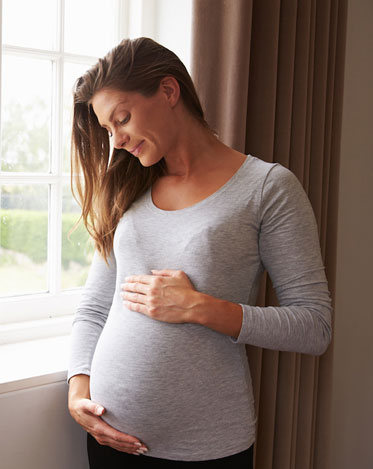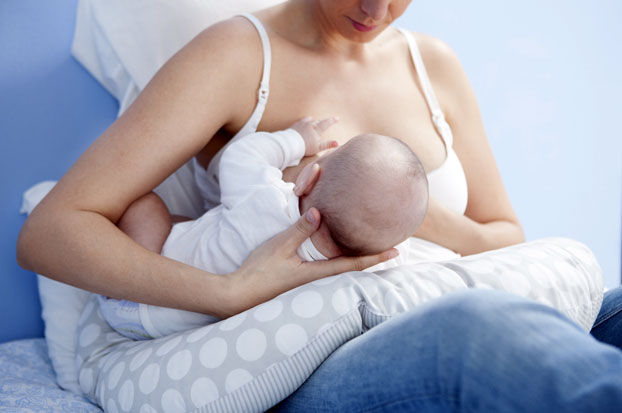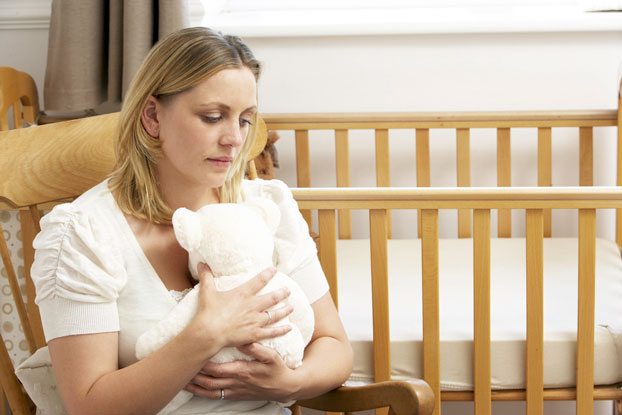Getting Pregnant After Age 35 (Advanced Maternal Age)
Advanced Maternal Age. Geriatric pregnancy. Elderly primigravida. None of these phrases are particularly endearing, but they are all terms used to describe a pregnancy in a woman in her mid-30s and beyond. Of course, women in their 30s and 40s are not old, but the female reproductive system evolved so that women are most fertile in the teens and 20s, and it’s a fact of biology that childbearing pregnancy becomes more complicated with age. This is particularly true for women aged 35 and older, and the medical community uses the term “advanced maternal age” to indicate women who are pregnant or want to become pregnant and may need to consider the risks associated with having a child later in life.
 How Does Age Affect Pregnancy?
How Does Age Affect Pregnancy?
A woman is born with all the eggs she will ever produce and those cells age along with the rest of her body. By the time a woman enters her 30s her eggs have become more difficult to fertilize and some, over time, are damaged. This resistance to fertilization can delay or impede conception and the possible damage to the egg cells increases the rate of possible birth defects. Furthermore, pregnancy stresses the body, and women who conceive at a later age are more susceptible to having a high-risk pregnancy.
Women who are considered being of “advanced maternal age” may not struggle with pregnancy and it is still absolutely possible for women in this age bracket to have healthy pregnancies. Nevertheless, when considering having children after the age of 35, it is wise to understand the realities of pregnancy later in life and to know what to expect throughout the whole process, from pre-conception to delivery.
Tubal Ligation (“Getting Tubes Tied”) Surgery Procedure & Recovery
Tubal Ligation is a surgical procedure that permanently prevents pregnancy. It is also casually known as “getting your tubes tied,” and involves the cutting or blocking off of the fallopian tubes. This stops the egg from traveling from the ovary to the uterus so fertilization and implantation cannot occur.
The Tubal Ligation Procedure
Tubal ligation is a relatively simple surgery. It can be done at any time, including immediately after giving birth, and many women prefer to have it done as part of a Cesarean section procedure.
During a standard tubal ligation, either general anesthesia or a spinal block is administered. If the operation is not part of a C-section, the surgeon makes two small abdominal incisions and inserts a small camera mounted on the end of a tube called a laparoscope. The abdomen is then inflated with gas, allowing greater visibility and access. The surgeon will then cut or cauterize each of the fallopian tubes and clamp or tie them off.
The Importance of Prolactin to Women Nursing Babies
Prolactin is a hormone produced by the pituitary gland in the brain. It plays a significant role in regulating many body functions, including ovulation, metabolism and immunity, but its primary purpose is to stimulate the mammary glands to begin milk production. Increased levels of the hormone is crucial to maintaining an adequate milk supply for nursing mothers. When not nursing, however, an imbalance of prolactin can be evidence of a serious health condition requiring medical assessment and treatment.
Milk Production
During pregnancy, a woman’s body starts to produce higher than normal levels of prolactin. This hormonal increase causes the mammary glands to begin preparation for milk production, but elevated levels of the hormone progesterone prevent the breasts from lactating before birth. Progesterone production decreases shortly after giving birth as prolactin continues to increase, stimulated in part by the baby’s first attempts to suckle at the breast, and this allows the breasts to begin lactating.

Pap Smear Expectations & Guidelines
One of the best things women can do to ensure their health is to get frequent Pap smear tests. A Pap smear is a brief medical procedure that checks for overall cervical health.
Every year, approximately 12,000 women will be diagnosed with cervical cancer and 4,000 women die from it. These tragic statistics are even more regrettable because cervical cancer is an essentially preventable disease. Pap smears are the only way to detect precancerous and cancerous cells in the cervix, but early detection has very high cure rates. A Pap smear is the main tool for reducing women’s risk of developing cervical cancer.
Not Your Mother’s Pap Smear: New Guidelines
Previous medical guidelines advised women get a Pap smear test every year. This was before the link between cervical cancer and the Human Papilloma Virus (HPV) was established. Doctors now know that certain strains of HPV are detected in almost all types of cervical cancers and co-testing for HPV combined with a Pap smear has allowed the guidelines to be modified.
5 Cervix Health Tips for Cervical Health Awareness Month
The United States Congress, in conjunction with the American Social Health Association (ASHA) and the National Cervical Cancer Coalition, designated January as Cervical Health Awareness Month to increase public knowledge of cervical health and encourage women to get screened for cervical cancer and vaccinated against the diseases that cause it.

Cervical Health Facts
The cervix is a long, cylinder-shaped passage between the vagina and the uterus. It has two main parts, the cervix itself and the opening of the cervical canal known as the “endocervix.” The cervix is covered in squamous cells and the endocervix is covered in columnar cells. These different types of cells meet at a point between the vagina and the uterus known as the “transformational zone.” The transformational zone is the part of the cervix that is most susceptible to developing cancer.
Recognizing & Recovering from a Miscarriage
Miscarriage frequently goes undiscussed in the broader culture, but it is not uncommon. It is estimated that between 10% and 20% of all pregnancies end in miscarriage, but that number is likely higher in reality because miscarriage can take place in the earliest stages of gestation before the pregnancy is detected.
Miscarriages occur for a number of reasons. Understanding what happens medically when a pregnancy is lost may provide a measure of comfort and understanding to women and their families affected by miscarriage.

What is a Miscarriage?
A miscarriage is defined as the spontaneous loss of a pregnancy before the 20th week of gestation. The risk for miscarriage is greatest during the first trimester of pregnancy when the embryo is rapidly developing. After the 12th week of pregnancy, the chances of miscarriage decrease significantly.
Unfortunately, once a miscarriage has begun it cannot be stopped with medical intervention. However, if a woman thinks she may be having a miscarriage, it is crucial that she seek medical care to ensure her own health and safety.
Hormone Replacement Therapy (HRT) for Women
During menopause the body stops producing the same levels of hormones that it has throughout the reproductive years. This hormonal decrease can result in unpleasant side effects such as hot flashes, vaginal dryness, and night sweats. Hormone Replacement Therapy (HRT) treats these symptoms with medication that replace the hormones, typically estrogen and progesterone/progestin, that are no longer being produced naturally in the body throughout menopause. HRT is also often used an effective prevention against osteoporosis (bone thinning).

Oopherectomy (Ovary Removal) Surgery Procedure & Recovery
An oophorectomy is a procedure involving the surgical removal of the ovaries. Oophorectomies treat serious gynecological conditions and diseases and are often done as part of a hysterectomy (removal of the uterus) or a salpingectomy (removal of the fallopian tubes). There are two types of oophorectomy: a bilateral oophorectomy removes both ovaries, and a unilateral oophorectomy removes one ovary.
Why is an Oophorectomy Necessary?
The ovaries have a significant role in hormone production, so an oophorectomy is normally performed only when absolutely necessary to treat specific gynecological disorders or diseases.
Gynecological conditions that may require a oophorectomy include:
- Ovarian cancer
- Endometriosis
- Noncancerous ovarian tumors, cysts or abscess
- Ovarian torsion (a twisted ovary)
- A history of or genetic predisposition to certain types of ovarian and breast cancer
How Stress Can Impact Your Fertility and the Ability to Get Pregnant
Life is inherently stressful. The pressures of work, the demands of maintaining important relationships, commitments that pull us in a thousand different directions, and the constant background noise of social media all conspire to stress us out. And add to that the intense stress of struggling with fertility issues. It’s a lot to handle! But can it prevent you from getting pregnant?

Stress and Infertility
Infertility, especially if experienced for an extended amount of time, is a particularly heavy burden to bear. It is not only personally stressful but it can also put a lot of strain on couples who are enduring the struggle together. But are emotional and physical stress also contributing factors to infertility?
Preventing & Treating Osteoporosis in Women
Bones are a living material. The body is constantly producing new tissue to replace bone that naturally breaks down. Osteoporosis is a disease that affects the body’s ability to make new bone and maintain adequate bone density, and can cause significant bone loss over time. As a result of osteoporosis, bones become weak and brittle and are prone to breakages.
Osteoporosis Risk Factors
An estimated 10 million Americans have osteoporosis and another 44 million have low bone density, which elevates their risk of developing the disease in the future. Anyone can develop osteoporosis, but women are four times more likely to suffer from the condition than men. Women are at a greater risk for osteoporosis because female bones tend to be smaller and thinner, and because estrogen plays an important role in regulating bone mass. Genetic and environmental factors can also raise a person’s chances of developing osteoporosis. Caucasian and Asian women are statistically more likely to develop osteoporosis, as are people who have a family history of the disease. Menopausal women also have a greater chance of developing osteoporosis since lower hormone production naturally decreases bone production.
Additional factors that are not related to genetics, gender or age can also increase a person’s risk of developing osteoporosis. An inactive or sedentary lifestyle, high levels of alcohol consumption, and smoking tobacco products raises the likelihood of osteoporosis.
The Flu Vaccine and Pregnancy
The influenza virus is a common but potentially dangerous illness and pregnant women are at a higher risk of contracting a severe case of the flu than the general population. Pregnancy naturally suppresses the immune system and stresses the heart and lungs in ways that cause pregnant women to be more susceptible to the flu, but a vaccine can safely protect women and babies from the illness and its complications.







